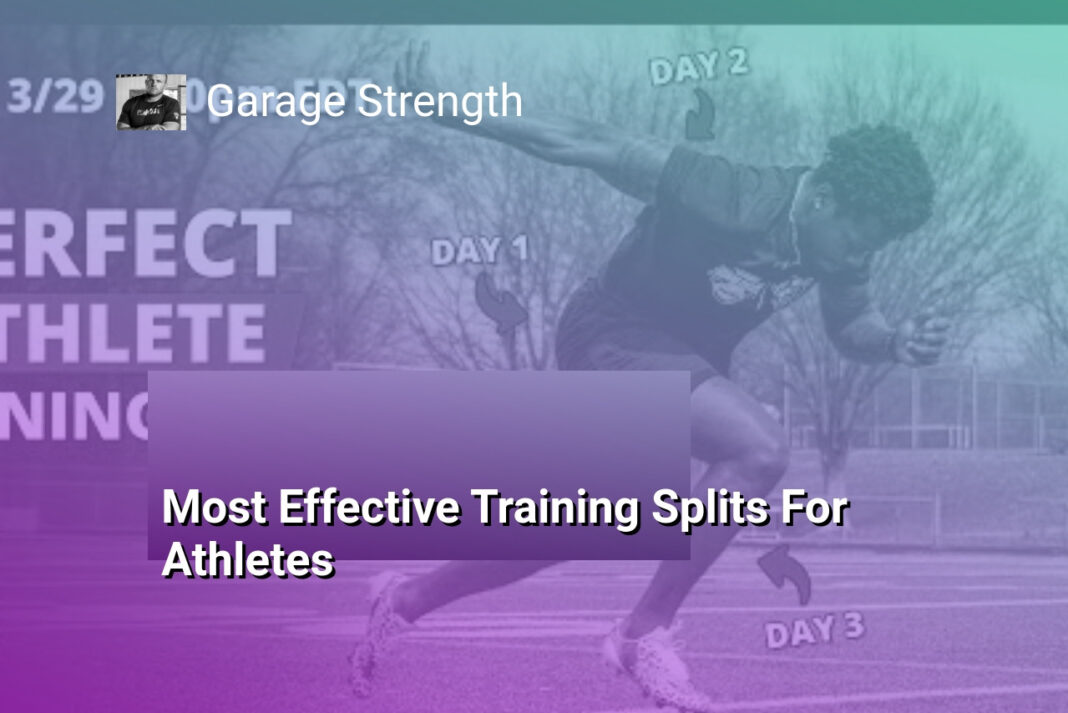The Bottom Line:
Here is a summary of the main points in first-person perspective:
- I believe that the optimal training split for athletes depends on factors such as their sport, experience level, and whether they are in-season or off-season. Elite athletes may require different splits compared to beginners or high school athletes.
- During the off-season, I recommend that athletes train 4-5 days per week to build strength, speed, and explosiveness. This frequency also helps instill a habit of hard training and can facilitate muscle growth.
- I think that athletes from different sports should have tailored strength training programs, with variations in exercise intensity and focus based on their specific requirements for impulse, absolute strength, speed, and endurance.
- When designing training splits, I consider the ratio of time spent on sport-specific training versus supplemental training. For example, a wrestler might spend 3 hours in the wrestling room for every 1 hour in the weight room, while a shot putter may have a 1:1 ratio.
- I typically structure 3, 4, and 5-day splits to include a combination of leg power days, upper body power days, athlete days (focusing on sport-specific movements), impulse days (for explosive speed work), and hypertrophy or strength days, depending on the athlete’s goals and capabilities.
Understanding the Importance of Training Splits for Athletes
The Importance of Training Frequency for Athletes
The frequency of training is a crucial factor in an athlete’s performance and progress. The number of days an athlete trains per week can vary depending on their sport, level of competition, and the phase of their training cycle. For instance, during the offseason, athletes may train four to five days a week to focus on building strength, size, and addressing weaknesses. However, during the competitive season, training frequency may be reduced to three days a week to allow for adequate recovery and to prioritize sport-specific training.
Tailoring Training Splits to Sport-Specific Demands
Different sports place varying demands on the body, and training splits should be tailored accordingly. For example, an 800-meter runner may spend the majority of their time training on the track, with strength training serving as a supplementary tool. In this case, for every 20 hours spent on the track, the runner may spend two to three hours in the weight room. In contrast, a shot putter may have a more balanced approach, spending equal amounts of time in the weight room and practicing their technique in the circle. Understanding the specific demands of each sport is essential in designing an effective training split.
Optimizing Training Splits for Different Goals
Training splits can be optimized to target specific goals, such as increasing strength, power, or hypertrophy. A three-day split may include a leg power day, an upper body power day, and an athlete day, focusing on sport-specific movements. A four-day split could add an impulse day, emphasizing explosive speed work for both the upper and lower body. For a five-day split, athletes may incorporate a hypertrophy or strength day, depending on their individual needs and goals. By strategically structuring training splits, athletes can maximize their performance and make the most of their time in the gym.
Comparing Different Training Splits: Bro Splits vs. Upper/Lower vs. Full Body
Bro Splits: Targeting Individual Muscle Groups
Bro splits, also known as body part splits, involve training specific muscle groups on separate days. For example, a typical bro split might include chest on Monday, back on Tuesday, legs on Wednesday, shoulders on Thursday, and arms on Friday. This approach allows for high volume and intensity on each muscle group, as the focus is solely on one or two areas per workout. Bro splits are popular among bodybuilders and those seeking hypertrophy, as the increased volume and frequency can stimulate muscle growth. However, this split may not be optimal for athletes who require more frequent stimulation of multiple muscle groups for overall strength and performance.
Upper/Lower Splits: Balancing Upper and Lower Body Training
Upper/lower splits involve alternating between upper body and lower body workouts. A typical upper/lower split might include upper body on Monday and Thursday, lower body on Tuesday and Friday, with Wednesday and the weekend as rest days. This approach allows for more frequent stimulation of each muscle group, as the upper body and lower body are trained twice per week. Upper/lower splits can be beneficial for athletes who require a balance of strength and hypertrophy, as the increased frequency can lead to greater overall gains. Additionally, this split can be more time-efficient than bro splits, as multiple muscle groups are trained in each workout.
Full Body Workouts: Maximizing Overall Strength and Performance
Full body workouts involve training all major muscle groups in a single session. This approach is often used by athletes who require overall strength and performance, as it allows for frequent stimulation of all muscle groups. Full body workouts typically involve compound exercises such as squats, deadlifts, bench press, and rows, which engage multiple muscle groups simultaneously. This split can be highly effective for athletes who have limited training time or require a high degree of overall strength and power. However, full body workouts may not allow for as much volume and intensity on individual muscle groups compared to bro splits or upper/lower splits.
Optimal Training Frequency: How Many Days Per Week Should You Train?
Optimal Training Frequency for Athletes
The optimal training frequency for athletes depends on several factors, including their specific sport, current training phase (in-season, off-season, or post-season), and individual goals. Generally, athletes should aim to strength train a minimum of three days per week to maintain and improve their performance. However, during the off-season, athletes can benefit from increasing their training frequency to four or five days per week to maximize their gains in strength, power, and hypertrophy.
Tailoring Training Splits to Sport-Specific Demands
Different sports place varying demands on the body, requiring athletes to prioritize certain aspects of their training. For example, an 800-meter runner may spend more time on the track and less time in the weight room compared to a shot putter, who may have a more balanced ratio of track and weight room training. When designing a training split, it’s essential to consider the specific demands of the sport and the athlete’s individual needs.
A typical three-day split for an athlete might include a leg power day, an upper body power day, and an athlete day focusing on sport-specific movements. A four-day split could add a full-body impulse day, while a five-day split might incorporate a hypertrophy or strength-focused day, depending on the athlete’s goals and capabilities.
Balancing Training, Recovery, and Accountability
While training frequency is crucial for athletic development, it’s equally important to prioritize recovery and maintain accountability. Athletes should ensure they have adequate rest between training sessions and incorporate proper nutrition and sleep habits to support their recovery and performance.
Working with a qualified strength and conditioning coach can help athletes develop an optimal training split that aligns with their sport-specific needs, individual goals, and recovery requirements. By striking the right balance between training frequency, intensity, and recovery, athletes can maximize their performance and make consistent gains in their chosen sport.
Customizing Training Splits for Different Sports and Goals
Tailoring Training Splits for Different Sports
When customizing training splits for different sports, it’s crucial to consider the specific demands and requirements of each discipline. For instance, an 800-meter runner’s strength training regimen will differ significantly from that of a shot putter. The 800-meter runner may focus more on endurance and speed work, with a lower volume of strength training, while the shot putter will prioritize explosive power and absolute strength, dedicating more time to weightlifting sessions.
The ratio of sport-specific training to supplemental strength training also varies among different sports. A wrestler might spend three hours in the wrestling room for every hour in the weight room, whereas a shot putter may have a 1:1 ratio of training in the circle to lifting weights. Understanding these ratios helps optimize the balance between sport-specific practice and strength development.
Adapting Training Splits to Athletes’ Goals and Capabilities
When designing training splits, it’s essential to consider the individual goals and capabilities of each athlete. Some athletes may require more emphasis on hypertrophy to gain muscle mass, while others may need to focus on strength or speed development. Assessing an athlete’s current fitness level, weaknesses, and areas for improvement will help determine the most appropriate training split.
For example, a three-day split might include a leg power day, an upper body power day, and an athlete day focusing on sport-specific movements. A four-day split could add an impulse day for upper and lower body explosive speed work, while a five-day split might incorporate a hypertrophy or strength day, depending on the athlete’s needs.
Progressively Increasing Training Volume and Intensity
As athletes progress through their training cycles, it’s important to gradually increase the volume and intensity of their workouts. During the postseason, athletes may start with three training sessions per week, focusing on simple movements and rebuilding foundational strength. As they enter the offseason, the training frequency can increase to four to five days per week, with a greater emphasis on building size, strength, and speed.
High school athletes, in particular, can benefit from training four to five days per week during the offseason, as it helps establish good training habits and can lead to rapid improvements in performance. However, it’s crucial to monitor their progress and adjust the training split as needed to prevent overtraining and ensure adequate recovery.
Sample 3-Day, 4-Day, and 5-Day Training Splits for Athletes
3-Day Training Split for Athletes
A well-designed 3-day training split for athletes should focus on developing leg power, upper body power, and overall athleticism. On the leg power day, athletes should perform exercises such as heavy squats and single-leg squats to improve lower body strength and power output. The upper body power day should include compound movements like bench press, pull-ups, and shoulder press to build strength and size in the chest, back, and shoulders. The athlete day should incorporate exercises that mimic sport-specific movements and improve overall athleticism, such as plyometrics, agility drills, and core work.
4-Day Training Split for Athletes
For athletes looking to take their training to the next level, a 4-day split can be an effective option. This split includes a leg power day, an upper body power day, an athlete day, and a full-body impulse day. The leg power and upper body power days follow a similar structure to the 3-day split, while the athlete day focuses on sport-specific training. The full-body impulse day is designed to improve explosive power and speed, incorporating exercises such as Olympic lifts, jump squats, and medicine ball throws. This additional day allows athletes to target specific areas of improvement and increase overall training volume.
5-Day Training Split for Athletes
For elite athletes or those with more advanced training goals, a 5-day split can be highly effective. This split includes a leg power day, an upper body power day, an athlete day, an impulse day, and a hypertrophy or strength day. The leg power, upper body power, and athlete days remain consistent with the previous splits. The impulse day focuses on developing explosive power and speed, while the hypertrophy or strength day is designed to increase muscle size or maximal strength, depending on the athlete’s specific needs. This split allows for high training volume and targeted improvement in key areas, but also requires careful planning and recovery to prevent overtraining.





